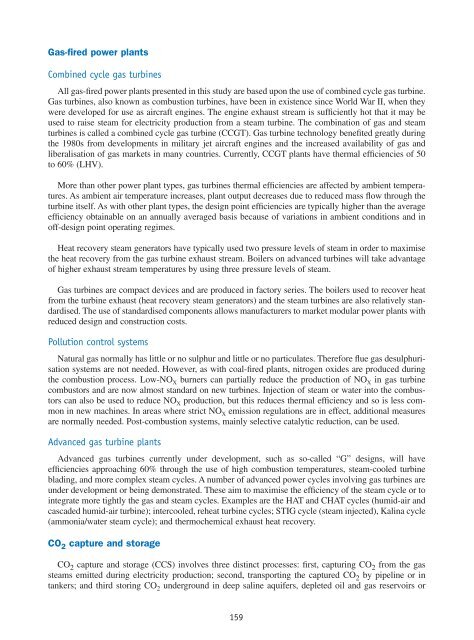Projected Costs of Generating Electricity - OECD Nuclear Energy ...
Projected Costs of Generating Electricity - OECD Nuclear Energy ...
Projected Costs of Generating Electricity - OECD Nuclear Energy ...
Create successful ePaper yourself
Turn your PDF publications into a flip-book with our unique Google optimized e-Paper software.
Gas-fired power plants<br />
Combined cycle gas turbines<br />
All gas-fired power plants presented in this study are based upon the use <strong>of</strong> combined cycle gas turbine.<br />
Gas turbines, also known as combustion turbines, have been in existence since World War II, when they<br />
were developed for use as aircraft engines. The engine exhaust stream is sufficiently hot that it may be<br />
used to raise steam for electricity production from a steam turbine. The combination <strong>of</strong> gas and steam<br />
turbines is called a combined cycle gas turbine (CCGT). Gas turbine technology benefited greatly during<br />
the 1980s from developments in military jet aircraft engines and the increased availability <strong>of</strong> gas and<br />
liberalisation <strong>of</strong> gas markets in many countries. Currently, CCGT plants have thermal efficiencies <strong>of</strong> 50<br />
to 60% (LHV).<br />
More than other power plant types, gas turbines thermal efficiencies are affected by ambient temperatures.<br />
As ambient air temperature increases, plant output decreases due to reduced mass flow through the<br />
turbine itself. As with other plant types, the design point efficiencies are typically higher than the average<br />
efficiency obtainable on an annually averaged basis because <strong>of</strong> variations in ambient conditions and in<br />
<strong>of</strong>f-design point operating regimes.<br />
Heat recovery steam generators have typically used two pressure levels <strong>of</strong> steam in order to maximise<br />
the heat recovery from the gas turbine exhaust stream. Boilers on advanced turbines will take advantage<br />
<strong>of</strong> higher exhaust stream temperatures by using three pressure levels <strong>of</strong> steam.<br />
Gas turbines are compact devices and are produced in factory series. The boilers used to recover heat<br />
from the turbine exhaust (heat recovery steam generators) and the steam turbines are also relatively standardised.<br />
The use <strong>of</strong> standardised components allows manufacturers to market modular power plants with<br />
reduced design and construction costs.<br />
Pollution control systems<br />
Natural gas normally has little or no sulphur and little or no particulates. Therefore flue gas desulphurisation<br />
systems are not needed. However, as with coal-fired plants, nitrogen oxides are produced during<br />
the combustion process. Low-NO X burners can partially reduce the production <strong>of</strong> NO X in gas turbine<br />
combustors and are now almost standard on new turbines. Injection <strong>of</strong> steam or water into the combustors<br />
can also be used to reduce NO X production, but this reduces thermal efficiency and so is less common<br />
in new machines. In areas where strict NO X emission regulations are in effect, additional measures<br />
are normally needed. Post-combustion systems, mainly selective catalytic reduction, can be used.<br />
Advanced gas turbine plants<br />
Advanced gas turbines currently under development, such as so-called “G” designs, will have<br />
efficiencies approaching 60% through the use <strong>of</strong> high combustion temperatures, steam-cooled turbine<br />
blading, and more complex steam cycles. A number <strong>of</strong> advanced power cycles involving gas turbines are<br />
under development or being demonstrated. These aim to maximise the efficiency <strong>of</strong> the steam cycle or to<br />
integrate more tightly the gas and steam cycles. Examples are the HAT and CHAT cycles (humid-air and<br />
cascaded humid-air turbine); intercooled, reheat turbine cycles; STIG cycle (steam injected), Kalina cycle<br />
(ammonia/water steam cycle); and thermochemical exhaust heat recovery.<br />
CO 2 capture and storage<br />
CO 2 capture and storage (CCS) involves three distinct processes: first, capturing CO 2 from the gas<br />
steams emitted during electricity production; second, transporting the captured CO 2 by pipeline or in<br />
tankers; and third storing CO 2 underground in deep saline aquifers, depleted oil and gas reservoirs or<br />
159

















